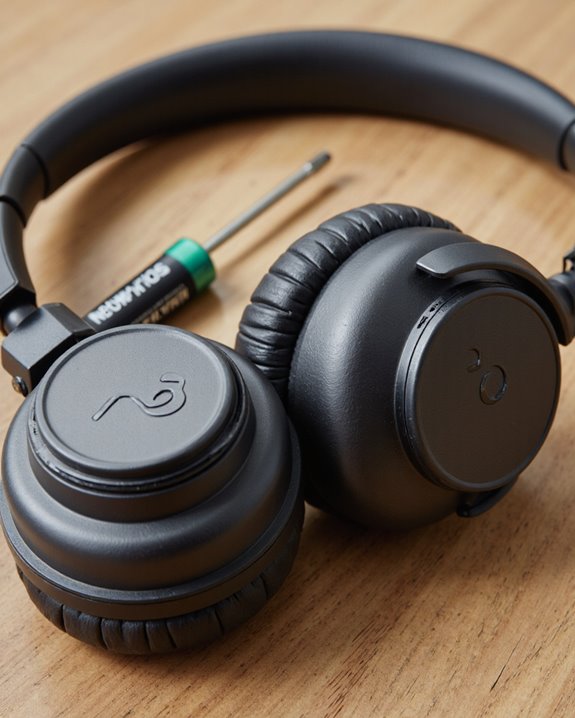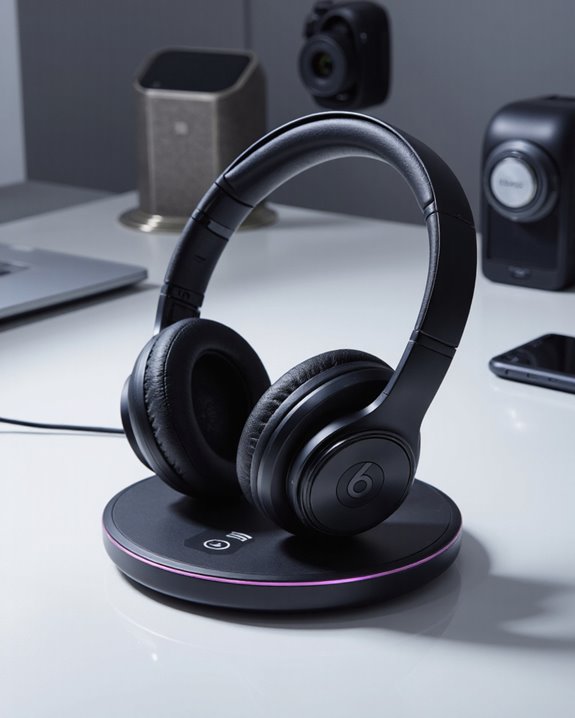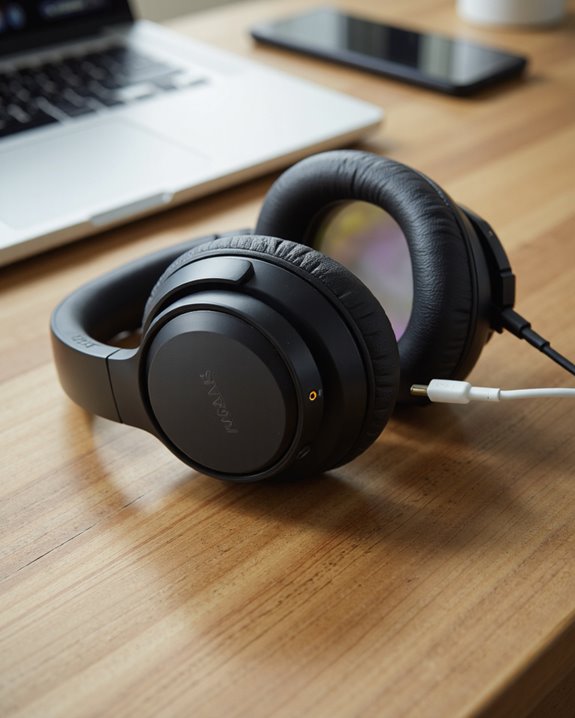As an Amazon Associate, we earn from qualifying purchases. Some links may be affiliate links at no extra cost to you. Although our opinions are based on curated research, we haven't used these products. Articles generated with AI.
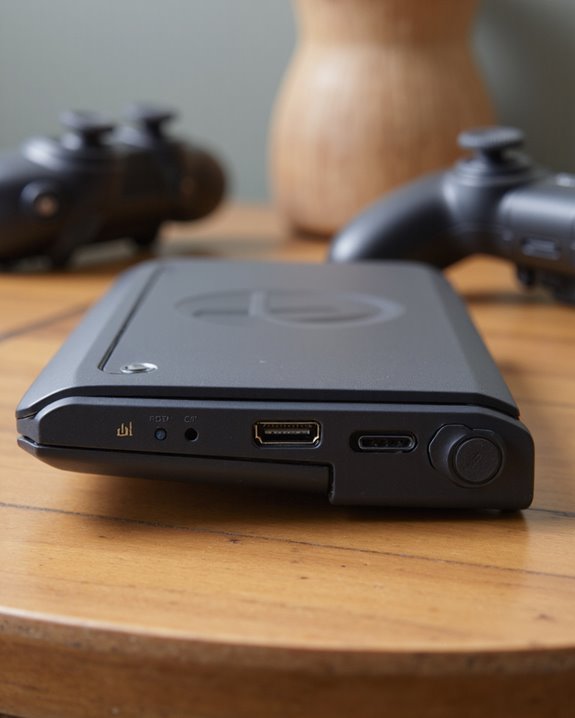
Does the PS Portal Have a Headphone Jack?
Headphone Jack on the PlayStation Portal****
The PlayStation Portal is equipped with a dedicated 3.5mm headphone jack for direct wired audio connection, supporting most consumer and gaming headsets up to 32 ohms impedance. This guarantees stable, low-latency sound without reliance on wireless technologies. The headphone jack offers straightforward plug-and-play operation, eliminating the need for adapters or extra setup. While wireless PlayStation Link headsets are also supported, traditional Bluetooth headphones are not. Additional connectivity and audio feature information follows.
Key Takeaways
- Yes, the PS Portal features a standard 3.5mm headphone jack for wired audio connections.
- Wired headphones and gaming headsets up to 32 ohms are fully supported via the headphone jack.
- The headphone jack allows for plug-and-play use with most popular headset brands.
- There are no additional physical audio outputs besides the 3.5mm headphone jack.
- Wireless Bluetooth headphones are not natively compatible, making the headphone jack the main option for most wired audio devices.
Physical Audio Ports on the PS Portal
A careful examination of the PlayStation Portal’s physical audio connectivity reveals a focus on streamlined, essential features. The device presents two primary physical ports, both situated along its bottom edge. One is a dedicated USB-C port, which serves exclusively for charging the internal battery and does not facilitate data transfer or accessory connections. The second, more pertinent to audio users, is a 3.5mm headphone jack. This port supports standard wired audio input/output, accommodating a wide range of consumer headphones and gaming headsets with up to 32 ohms impedance. No additional physical audio or video outputs are present, emphasizing reliance on the headphone jack for personal listening. The built-in microphone adds onboard voice capability but does not function as an external audio input port. For enhanced wireless audio experiences, many users might consider headphones equipped with Bluetooth 5.3 technology for seamless connectivity.
Connecting Wired Headphones With the 3.5mm Jack
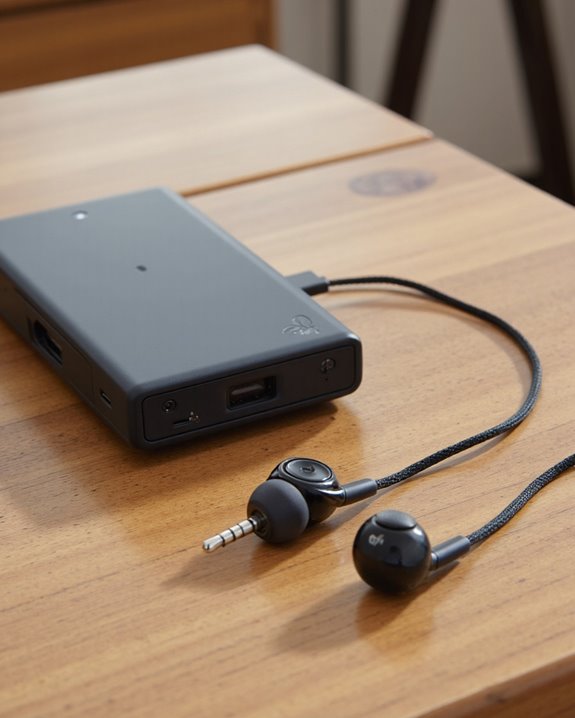
Following the identification of the PlayStation Portal’s dedicated 3.5mm audio port, connecting wired headphones becomes a direct and uncomplicated process. Users simply insert the headphone plug into the 3.5mm jack—typically positioned at the bottom of the device—with no need for additional setup, pairing, or software adjustments. This standard port supports plug-and-play functionality, automatically routing audio to the connected headphones.
The wired connection benefits are notable: it delivers stable, latency-free audio without reliance on battery life or wireless signals. This reliability appeals to users seeking seamless, uninterrupted play. However, potential headphone compatibility issues may arise if headphones use non-standard plugs or require additional adapters. Overall, the PS Portal’s inclusion of a 3.5mm jack enhances convenience and supports wide-ranging wired headphone use. Wired headsets provide zero-latency audio through direct connection, ensuring consistent performance during gameplay.
Compatibility With Popular Wired Headsets
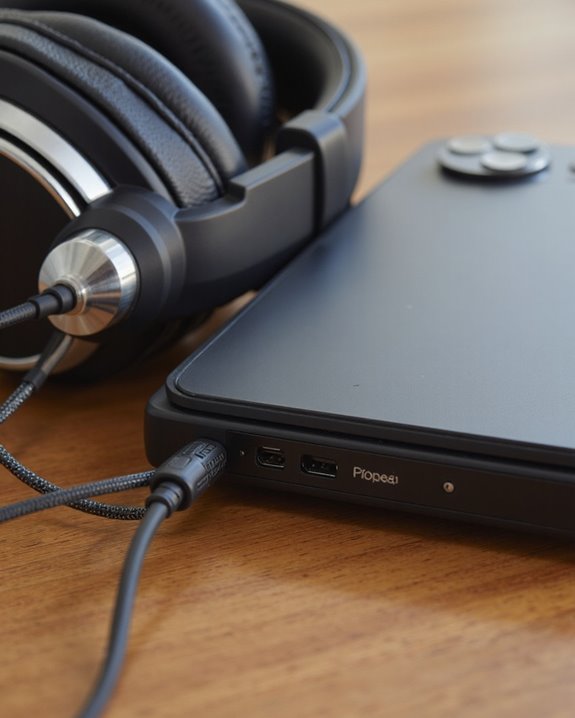
With the inclusion of a standard 3.5mm headphone jack, the PlayStation Portal guarantees broad compatibility with a diverse range of popular wired headsets. Compatibility testing confirms that many wired headset brands—such as Sony’s Inzone H3, SteelSeries, Turtle Beach, HyperX, and Razer—function reliably via the 3.5mm connection. The Portal’s built-in amplifier supports headphones up to 32 ohms, which encompasses most consumer headsets, ensuring consistent audio levels and quality. Virtual surround sound and customizable audio settings are available through these wired connections, enhancing both multiplayer coordination and single-player immersion. Wired headset brands have reported no significant latency or power issues during compatibility testing, making the device suitable for real-time gaming. This broad compatibility provides users with flexibility and confidence when selecting their preferred headset model. Additionally, many advanced wireless gaming headsets offer 7.1 surround sound technology that can complement the Portal’s audio capabilities when used with appropriate adapters.
Wireless Audio Options Available for PS Portal
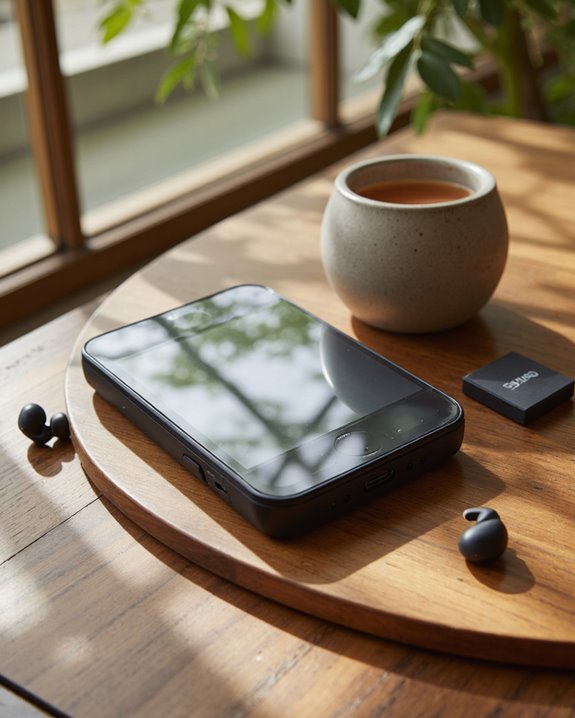
The PS Portal offers several wireless gaming audio solutions, each with distinct implications for audio latency and compatibility. The device supports ultra-low latency—sub-20ms—when paired with PlayStation Link-compatible headsets such as the PULSE Explore and PULSE Elite, providing precise synchronicity essential for competitive gaming scenarios. These proprietary devices also enable seamless switching between the PS Portal, PS5, and supported PCs. While traditional Bluetooth headphones are not natively compatible, users can connect non-PlayStation Link devices via Bluetooth dongles. However, this introduces higher latency, which may impact gaming responsiveness, though it remains a cost-effective alternative. PlayStation Link options generally yield superior sound quality and minimal delay, but the limited compatibility restricts headset choice. Consumers must weigh performance, versatility, and price when selecting a wireless audio solution.
Understanding PS Link Technology
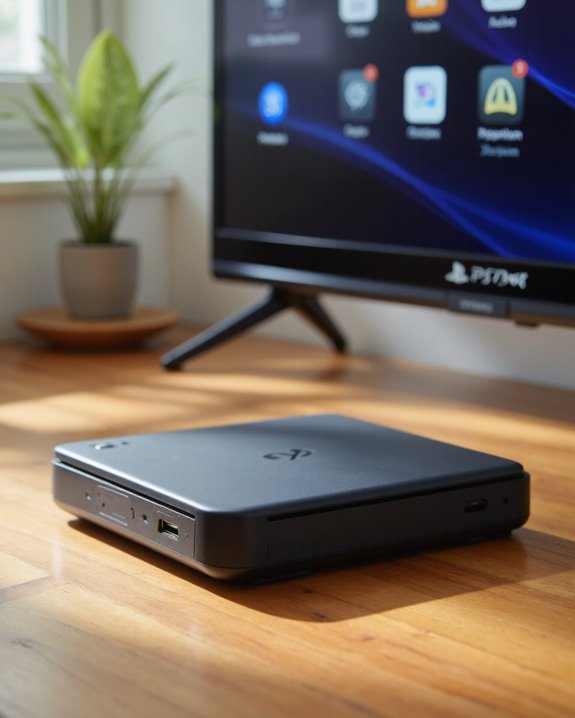
Although wireless audio standards are ubiquitous in gaming, PS Link technology stands apart as Sony’s proprietary solution designed exclusively for the PlayStation ecosystem. This wireless technology offers direct connectivity between the PlayStation Portal and select Sony audio devices, specifically the Pulse Elite headset and Pulse Explore earbuds. PS Link distinguishes itself from conventional Bluetooth by delivering consistently high signal quality and virtually no audio latency, optimizing real-time gaming experiences. Integrated seamlessly with the PlayStation Portal and PS5, PS Link eliminates the need for additional dongles or transmitters, streamlining setup and enhancing security through limited device compatibility. As a closed system, PS Link currently restricts usage to Sony’s products, ensuring a tailored user experience while aligning with Sony’s broader strategy of ecosystem integration and superior wireless technology performance.
Limitations of Bluetooth Headphone Connectivity
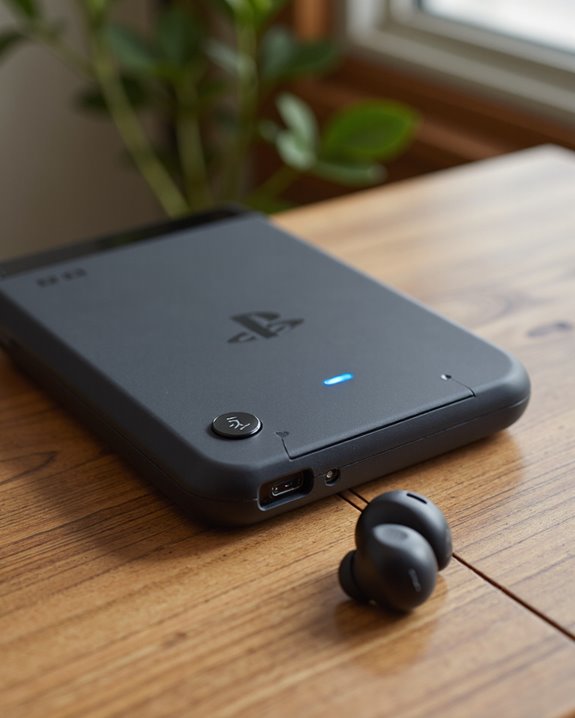
Despite the prevalence of wireless audio solutions in modern gaming devices, PlayStation Portal users encounter notable restrictions due to the absence of native Bluetooth headphone connectivity. This design choice introduces significant Bluetooth limitations, as users are confined to wired headphones via the 3.5mm jack or proprietary PS Link-compatible headsets, such as the Pulse series. Unlike other gaming platforms that offer broader wireless support, the Portal’s lack of Bluetooth radio excludes most third-party wireless headphones, creating wireless inconveniences for those accustomed to universal Bluetooth compatibility. Although Wi-Fi 5 is supported for network connectivity, it does not facilitate audio pairing. Consequently, users seeking a seamless wireless experience must either invest in PS Link devices or accept the constraints of wired connections, impacting overall convenience and flexibility.
Using Audio Adapters and Workarounds
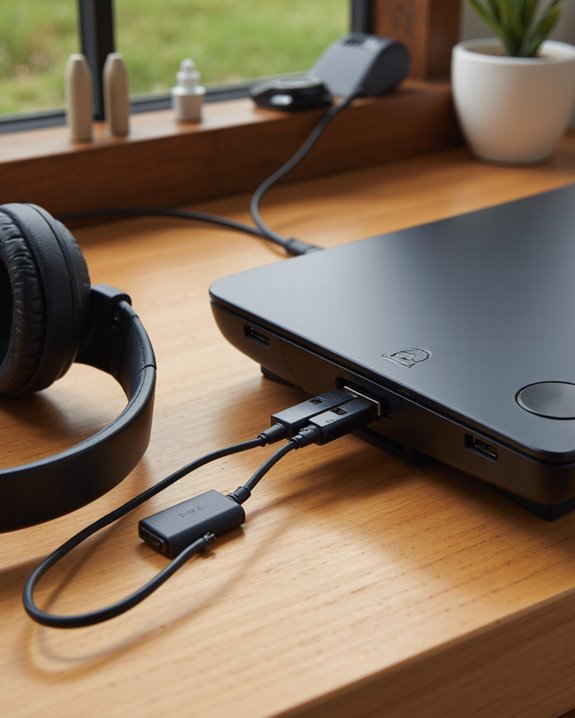
Several practical solutions exist for PlayStation Portal users seeking to expand audio compatibility beyond native options. The most direct method is to use wired headphones or gaming headsets with a 3.5mm connector, leveraging the Portal’s built-in amplifier, which supports headphones up to 32 ohms. This approach avoids adapter functionality and latency concerns entirely. For those preferring wireless audio, Bluetooth transmitters, such as the AirFly Pro, can connect to the Portal’s headphone jack, enabling the use of non-PS Link Bluetooth headphones. While effective, such adapters introduce additional setup steps and potential wireless limitations, like increased complexity and added cost. Alternatively, users may connect wireless headsets to the PS5 via a 2.4GHz dongle, though this requires proximity to the console for best signal integrity.
Supported Audio Quality and Virtual Surround Features

The PS Portal delivers robust virtual audio quality through its 3.5mm headphone jack, powered by a built-in amplifier designed for headphones up to 32 ohms. This guarantees clean, lag-free sound, essential for immersive soundscapes in gaming environments. Wired connections outperform wireless alternatives in clarity and latency, making them the preferred choice for discerning users. The device’s virtual surround sound capability, processed via software, emulates multi-directional speaker setups, enhancing positional accuracy during gameplay. Ideal results depend on headphone quality; higher-end models render virtual surround effects more precisely. While built-in speakers offer a basic audio option, they lack the depth and spatial detail of a good wired headset. Users are encouraged to adjust audio profiles for genre-specific enhancements.
Managing Audio Routing and Microphone Use
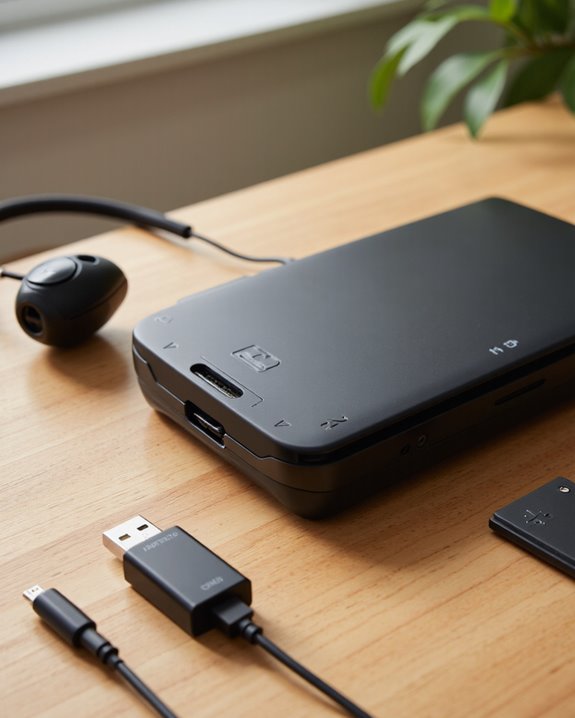
How can users effectively manage audio routing and microphone use on the PlayStation Portal? The device provides flexible audio routing options, allowing users to select between built-in speakers and wired headphones via its 3.5mm jack. For wireless audio, PS Link technology—exclusive to compatible Sony headsets—delivers ultra-low latency and lossless sound, enhancing both immersion and microphone performance. Importantly, standard Bluetooth headphones are unsupported. Audio customization is accessible through the Portal’s interface, enabling users to adjust volume and fine-tune output settings, though detailed controls are unspecified. Microphone use is streamlined: a built-in mic beneath the screen supports voice chat, or users can connect a compatible external mic through the headphone jack. Placement of the microphone may influence clarity, particularly in environments with background noise.
Tips for Optimal Audio Experience on PS Portal
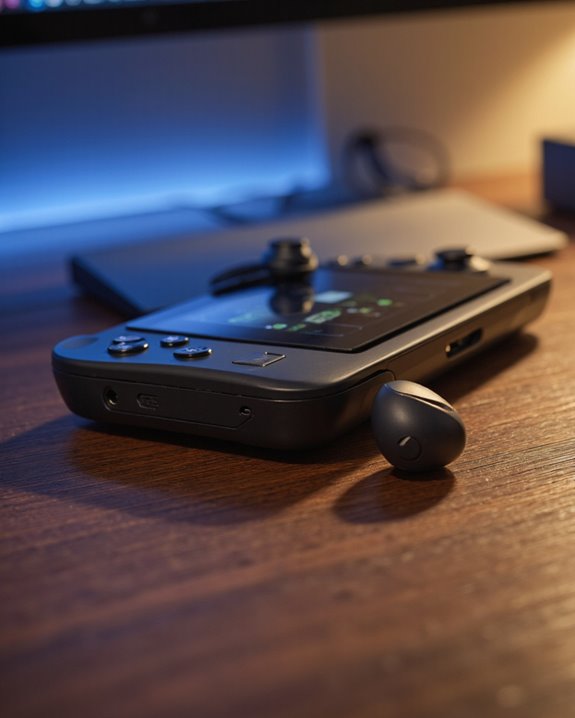
Optimizing audio on the PlayStation Portal involves more than simply plugging in headphones—users must consider connection types, device compatibility, and in-game settings to achieve the best possible experience. Utilizing the 3.5mm jack enables direct use of wired headphones, which guarantees reliable audio quality and minimal latency. For wireless solutions, PlayStation Link technology—compatible with PULSE Explore earbuds—offers low-latency, high-fidelity sound, though at a premium price point. Audio enhancements such as virtual surround sound can be activated for greater gaming immersion, especially in action or adventure titles. Adjusting audio settings based on specific game genres, and regularly monitoring these configurations, further refines the listening experience. A stable high-speed internet connection (at least 15Mbps) is also essential for consistent audio quality.
Frequently Asked Questions
Can the PS Portal Play Audio Through Both Speakers and Headphones Simultaneously?
Like a gate with only one open path at a time, the PS Portal’s audio settings prioritize either speakers or headphones, not both. This limitation guarantees sound quality, but simultaneous audio output through both is not specified in documentation.
Does the PS Portal Support Voice Chat Through Its Headphone Jack?
Voice chat functionality is supported through the PS Portal’s headphone jack when used with compatible wired headphones and a separate microphone. Headphone compatibility issues may arise due to the lack of Bluetooth support, necessitating wired solutions or external adapters.
Will Firmware Updates Add Bluetooth Headphone Support in the Future?
Buzzing with speculation, the question of Bluetooth compatibility continues to captivate consumers. Currently, no official confirmation exists regarding future updates. Sony’s silence sustains suspense, while demand and competitive pressure might eventually influence their approach to wireless audio.
Is the PS Portal’S Headphone Jack Compatible With Inline Controls on Headsets?
The current question concerns headset compatibility and whether inline controls on headsets function with the PS Portal’s headphone jack. Official information is lacking, so compatibility may vary depending on headset design, potentially requiring testing or additional adapters.
Are There Parental Controls for Headphone Volume on the PS Portal?
While the PS Portal offers robust parental settings for content and usage, it particularly lacks specific volume limits for headphones. This contrast highlights a gap; parents seeking headphone volume control must rely on external solutions or future software updates.


